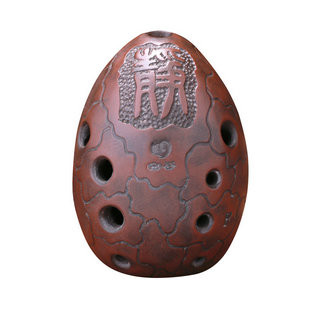Hello, Lovelies, today I will be again talking/explaining to you ancient instruments from China. I hope you enjoy and learn something!
1. Xiao
 |
| Credit: DHgate.com |
Xiao is one of the oldest musical instrument in China. It's a kind of wind instrument, it enjoyed a time honoured history. The melody of the vertically-played bamboo flute or Xiao in Chinese reminds people of a lonely moon highly hanging in the sky of a frosty autumn night. The sound of it is the sound of nature, the timber is soft and elegant.
The earliest Xiao appeared during the
Han Dynasty which was around 206BC - 220AD, and it was then called Qiangdi, which was popular among the
Qiang people in
Sichuan and
Gansu Provinces. in the 1st century BC, it became popular in the
Yellow River region. Later, it was developed into an instrument with six holes and today's Xiao developed to eight holes.
2. Xun
 |
| Credit: Sound of Mountain Music |
Xun is a kind of wind instrument. It is one of the oldest musical instruments found so far in China with a history of more than 7,000 years, and play an important role in world music circle. The instrument has been found along the
Yangtze River and the Yellow River as Neolithic relics, and I believed very popularly in ancient China. the ancestors use a kind of oval stone with naturally formed holes on it to hunt preys. When thrown it at the animals, the stone produces a whistling sound as the air flowing through the hole, which could have provided inspiration for early wind instruments.
Xun is easily made of clay with an egg shep and there are no more than ten holes on the surface. it can produce sound with a tamber similar to that human voice and is suitable for performing some lamenting aria. it is often accompanied by the
Chi, a bamboo pipe with eight holes.
3. Drum
 |
| Credit: DHgate.com |
China, Mesopotamia, ancient Egypt, are regarded as the home of a drum. As a traditional percussion instrument, drum occupies a prominent place in Chinese culture. According to the ancient literature, it might be as old as Chinese History itself.
The existing earliest documentation of its application occurs in Oracle Inscriptions of the Shang Dynasty which is around 16000 BC - 1100 BC. As an old and wonderful form of art, the frum has been employed in almost every aspect of Chinese social life, including sacrificial and worshipping ceremonies, farming and warfare.
4. Dizi
 |
| Credit:Amazon.com |
Dizi is a kind of ancient Chinese instrument and is the most representative musical instrument with strong ethnic characteristics. Dizi is always performed on occasions, such as Chinese traditional orchestra, a western symphony orchestra and so on. It's regarded as in inseparable part of wind instruments.
Most of Dizi is made of bamboo Dizi has a nice sound effect. For many Chinese people, the melody of the transversely-played bamboo flute calls to mind a picture of a country cowherd riding a bull in the spring breeze. The gnarls in the long bamboo pipe have been eliminated. There are one blowing hole, one affiliated hole and six sound holes. the blowing hole is the first hole of the Dizi/Flute, where the air s blown to make sounds. Next one is the affiliated hole which is cover by the membrane of the bamboo or bulrush.
5. Waist Drum
 |
| Credit: Top China Travel |
Waist Drum, is a traditional Chinese Drum, mainly popular among people in north China, especially in
Shanxi Province. Waist Drum is usually played by a man as the instrument shows a muscular feature of men and often accompanied by dancing movements as well. Given this nature of easy dancing when playing at the same time, the waist drum is commonly used in the
Yangge dancing as well.
6. Suona
 |
| Credit: Pinterest |
The suona was first introduced to ancient China from Persia. it is one of the typical Chinese traditional. instruments. it is also commonly called laba (meaning horn in Chinese) in China and bayin (meaning eight tunes) in Guangdong Province. the suona has a distinctively loud sound and is used in many Chinese traditional music bands. it is quite common instruments in northern China, particularly the provinces of
Shandong, Shanix and
Henan.
Reflection: I think I did very well explaining what they are, what they are made of and how they sounded. Next time learns more and finds out if they are still popular or not.
Hey, lovely people hope you have enjoyed reading and learning some Chinese ancient history. I hope you all learned something has a great day Bye!






No comments:
Post a Comment
Comments
Please structure your comments as follows:
Positive - Something done well
Thoughtful - A sentence to let us know you actually read/watched or listened to what they had to say
Helpful - Give some ideas for next time or Ask a question you want to know more about